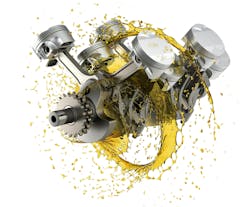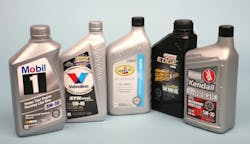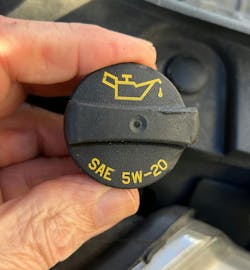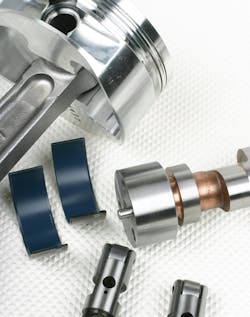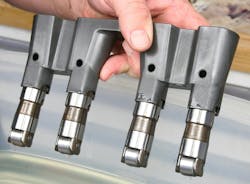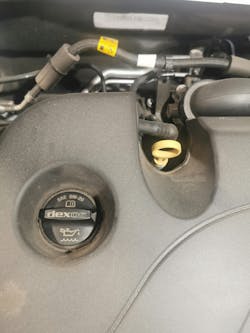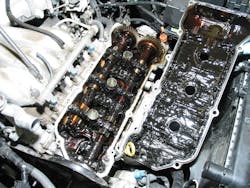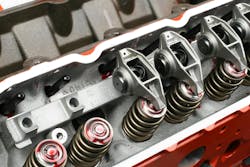Unfortunately, today’s drivers do not tend to check engine oil levels manually, as they tend to rely on instrument panel displays to remind them of the next oil change interval. Some of today’s engines don’t have dipsticks but there is a dash reading and procedure to verify the proper level.
In addition, some vehicle owners don’t pay attention to the type and/or viscosity requirements, potentially assuming that if oil is at the correct level, it doesn’t matter. This attitude is a recipe for long-term disaster. Choosing the correct type and viscosity is critical in terms of engine longevity, engine power output, fuel economy and emissions.
The engine oil of choice must prevent engine component wear, limit timing chain wear, and prevent sludge, varnish, and oil deposits. It must control deposits in the turbocharger, on the engine’s pistons and prevent low-speed pre-ignition (LSPI). LSPI is a potentially catastrophic engine problem that occurs when tiny particles of fuel and oil self-ignite in the combustion chamber. Turbocharged gasoline direct-injection engines in particular are prone to LSPI. Rods, pistons, piston rings, cylinder walls and spark plugs can all be damaged by severe LSPI conditions.
Adhering to the manufacturer’s recommended engine oil ensures that the oil will feature the required oil additives to prevent LSPI, limit oil volatility, wear, deposits, sludge, foaming, and still supply the critical cleaning and lubricating protection.
The manufacturer is going to be specific on the type of oil (conventional, semi-synthetic or full synthetic), the oil grade (SJ-SP, GF-6A, GF6B), any other specific specifications and the engine oil viscosity. All these pieces of information must be known before adding new oil into any customer’s engine.
Once the engine manufacturer specifications for engine oil are known, don’t select an oil simply based on the viscosity rating. Examine the oil bottle/container or bulk oil information package and ensure that the chosen oil meets the needed specifications. The engine oil container's label must provide the oil type, viscosity, OEM specific performance specifications and display one or a combination of the following symbols.
The Symbols
The American Petroleum Institute (API) Service Symbol “Donut”: The API provides a license to apply the “Donut” symbol to ensure consumers buying that engine oil that it meets API’s engine oil standards.
The American Petroleum Institute (API) “Starburst”: The API “Starburst” is another symbol to look for on the package or specification sheet of the engine oil you are installing. This symbol signifies that the oil meets the most up-to-date specification provided by the International Lubricant Specification Advisory Committee and the engine oil will meet the additional fuel economy and emission system protection requirements. As of May 1, 2021, all oil products displaying the “Starburst” must meet the API SP/Resource conserving specs.
International Lubricant Specification Advisory Committee (ILSAC) “Shield”: The “Starburst” certification will remain on legacy products (0W-20, 5W-20, 0W-30, 5W-30, 10W-30), but the “Shield" is the new identification mark for the ILSAC SAE 0W-16 viscosity engine oil. ILSAC GF-6 oil specifications are now broken into two separate standards, ILSAC GF-6A for legacy viscosity grades and ILSAC GF-6B for SAE 0W-16. ILSAC GF-6A and its legacy grades will be backwards compatible, but the ILSAC GF-6A is not.
Oil Type
There are three common types of engine oil used today. Conventional engine oil is a base mineral oil, derived from crude oil-based products. Synthetic engine oil is a manufactured chemical compound that is engineered to provide enhanced lubrication properties and supply significant benefits. Synthetic engine oils provide superior low temperature performance, higher thermal stability, lower volatility, better shear performance and other enhancements over conventional engine oils. Semi-synthetic engine oil is a combination of conventional oil and synthetic oil. There is no classification as to how much synthetic oil is blended with conventional engine oil to create a semi-synthetic engine oil blend.
Viscosity
It should be obvious that engine oil needs to be thin enough to provide lubrication upon cold startup in order to provide critical lubricating oil film to all components, yet be “thick” enough to provide lubrication and heat transfer when the engine is at operating temperature. While specific engines may call for 0W, 5W, 10W or 15W for “cold” operation, the “hot” viscosity rating of 20 or 30 will provide the needed lubrication.
In very broad and generic terms, as engine oil passages/orifices/paths become tighter, thinner cold viscosities may be needed. As temperatures and operating conditions (cylinder bore expansion, higher engine speeds, etc.) change, thicker formulations may be needed. Of course, in this article, we’re primarily focusing on street-driven and un-modified engines. For racing/heavy duty applications, “thicker” hot viscosity ratings may need to increase.
The viscosity numbers refer to the oil’s viscosity or thickness. The oil viscosity number that precedes the “W” for winter, stands for the oil's thickness at zero degrees Fahrenheit (or minus 17.8 Celsius). The lower the number the thinner the oil at that temperature. The oil viscosity number after the W refers to the oil’s viscosity at 212 Fahrenheit (100 Celsius), indicating the oil’s resistance to thinning when hot.
Oil viscosity ranges have, in recent years, evolved according to the specifications required by the automakers, based on specific engine designs in order to deliver the required lubrication to ever-advancing internal combustion engine designs. Adherence to the specified viscosity ranges has become increasingly important and is not to be ignored.
You should be aware by now that the trend in oil viscosity has been moving to lower-than-traditional levels. As a for-instance, 0W-16 is now common in Toyota and Honda engines. Interestingly, 0W-8 has been specified in Japan-based Hondas for some time now. Cold viscosity numbers like that may sound scary, but we need to bear in mind that the automakers have reasons to specify such levels based on their research and development.
Low viscosity oils considerably lower the energy losses that are attributed to engine oil and its viscosity causing friction (main/rod/cam bearing friction, piston to bore friction) but these low viscosity oils can have a negative effect and may increase friction on other parts of the engines such as the camshaft and lifters/followers.
Most of today’s engines are fitted with electronically controlled variable displacement oil pumps. These oil pumps will easily supply the needed engine lubrication at the desired pressure and volume to fully compensate for the oil’s thin viscosity. Also, as compared to older flat-tappet lifters and friction-inducing rockers, the trend towards using roller lifters and roller rockers significantly reduce friction, allowing the use of thinner viscosity oil.
Today’s engines feature much tighter tolerances and clearances, requiring a thinner oil to be delivered upon cold startup. Also, tiny orifices featured in oil activated and controlled variable valve timing actuators depend on the engine oil’s low viscosity for proper functionality especially when the engine is cold. Oil that is too “thick” under startup conditions can starve critical components until temperatures rise and sufficient oil flow is obtained. The wrong viscosity oil can easily cause drivability concerns, hesitation, performance issues and even possibly the MIL being illuminated if the wrong viscosity engine oil is installed. In a nutshell, the oil must be “thin” enough under startup and initial warmup to lubricate, stabilize and become more viscous to properly lubricate components once the engine reaches full operating temperature. It’s not as easy task to provide the proper balance.
Low viscosity oil reduces engine warmup times, improves cold weather starts and increases fuel economy. Changing from the old familiar 5W-30 to 0W-16 represents a 2% increase in engine fuel economy and the use of the ultra-low viscosity oils such as the 0W-8 could further improve engine fuel economy by another 0.6 to 1.1%.
Many automakers tend to establish their own proprietary engine oil specifications to meet the specific designs and requirements of their engines, emission systems and the engine operating systems. These proprietary formulations often have modified additive packages and can pass specific chemical and physical oil tests that may not be included in the standardized oil testing procedures. GM’s dexos Gen2 for example, supplies extra protection against LSPI, uses a new oil performance test that GM developed to protect turbochargers and a newer oil aeration test.
As another example, Ford 5.0L engines featured in the F-150 lineup are specified for either 5W-20 or 5W-30 oil, which can be confusing for do-it-yourselfers and some professional techs. The safest way to decide on which range to use is to refer to the owner’s manual and also pay attention to the markings on the oil fill cap, which will clearly indicate what viscosity range to use. Possible yearly design improvements in valvetrain, cam timing actuators and piston cooling nozzles may have prompted the automakers to alter the viscosity range for specific engines. Other examples of manufacture-specific specification are dexosD, FCA Material Standard MS-6395, VW 508.00, BMW LL-04 and Ford WSS-M2C962-A1. This is something that we need to pay specific attention to, when providing an oil change.
Does this mean that you must use only the automaker’s brand of oil? Of course not. As long as the oil meets (or exceeds) the automaker’s formulation specs, you’re good to go.
Keep in mind that automakers don’t arbitrarily change oil specs for the fun of it. There are many variables that prompt them to decide on oil viscosity and formulation in an effort to enhance engine longevity, performance, emissions and fuel economy. The automakers aren’t playing with oil requirements just to make our lives more difficult.
One of the areas easy to overlook involves the use of start-stop technology, wherein the hydrodynamic oil film may momentarily collapse between the stop function and the re-start function. This concern may require special oil properties and unique bearing materials to be used to prevent wear. Also, consider that hybrid engines that are not running can allow moisture to form on pistons and cylinder walls that will need to be dealt with by the engine oil and its additive package when the engine starts running again and the moisture is deposited in the oil pan.
Adding the incorrect oil to an engine will not result in immediate engine damage. However, even though an engine doesn't completely seize up from using the “wrong” engine oil, that doesn't mean damage doesn't occur. For instance, if a Corvette LT4 engine was given starburst oil because someone didn't read to know it needed a special oil, there wouldn't be immediate failure. But over time, problems would likely develop. Oil viscosity and formulation is critically important in turbocharged engines, due to the extreme heat and turbine speed that the oil must deal with to prevent coking and turbo failure.
The correct/specified oil will feature the required balance of base oil and additives for a given engine. If an oil lacks the right components or the right balance, bad things may happen. Depending on which additive is missing, over time this may result in metal-on-metal contact in the valve train. An engine oil lacking certain antioxidants could see heat damage since local hot spots in the engine spike to 400-600 degrees Fahrenheit. Over time this buildup of varnish can keep parts from moving properly. Using an oil that does not meet the automaker’s specs can lead to varnish and sludge buildup, even if oil change intervals are conducted within/near the OE interval recommendations.
We simply cannot take engine oil for granted, tossing in whatever oil is handy or available at the lowest price. Today’s ever-evolving engine designs present specific lubrication demands that require the use of specific thickness ranges and friction-modifying formulations.
